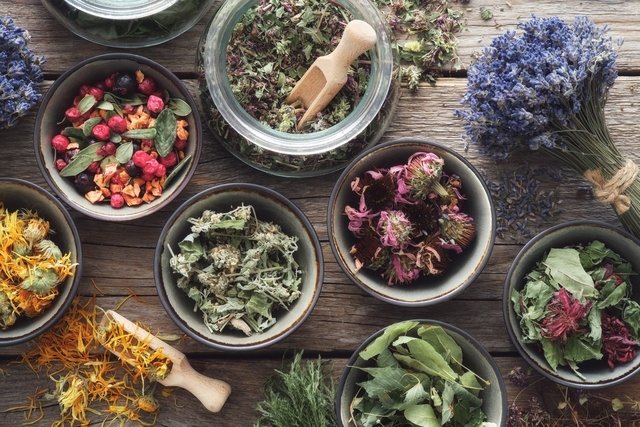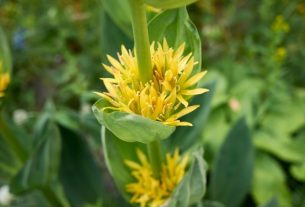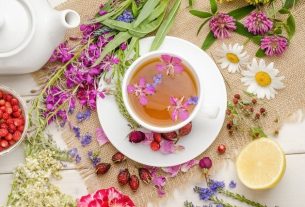Some home remedies, such as passion fruit juice with soy flour and lavender essential oil, have calming properties that help reduce irritation and improve sleep quality during menopause.
Furthermore, açaí juice with Peruvian maca and cocoa increase libido and improve mood, physical and mental disposition during menopause, because they contain flavonoids, caffeine and catechins, which are bioactive compounds with stimulating and tonic action.
These home remedies help alleviate menopause symptoms such as insomnia and hot flashes. However, they should not replace the treatment recommended by the gynecologist, being only a complement to menopause treatment. Learn about other symptoms of menopause.

Home remedy options
Some home remedies that can help alleviate menopause symptoms are:
1. Passion fruit juice with soy
Passion fruit juice has a calming and sedative action, helping to reduce irritability and insomnia. Soy flour contains isoflavones, a compound that balances estrogen hormone levels in the body, helping to control hot flashes.
Ingredients
- 1 tablespoon of soy flour;
- Pulp of 1 passion fruit;
- 1 tablespoon of honey;
- 1 glass of filtered or boiled water.
Preparation mode
Place all ingredients in a blender and blend for 3 minutes. Drink 3 glasses of this juice a day.
Because it contains soy, this juice should be avoided by women who take hormone replacement therapy or use medications such as anticoagulants, tamoxifen or anti-estrogens. Women with estrogen-dependent cancer or a family history should consult a doctor before consuming this juice.
2. Lavender essential oil
Lavender essential oil contains linalool and linalyl acetate, compounds with calming and relaxing effects, which help combat insomnia, as well as improving mood and general well-being.
Ingredients
- 1 tablespoon of vegetable oil (jojoba, coconut, olive or almond);
- 1 drop of lavender essential oil.
Preparation mode
In a small container, mix the vegetable oil well with the lavender essential oil. After washing and drying your skin well, apply the mixture to your face and massage for 2 minutes.
3. Blackberry tea
Blackberry tea has good amounts of phytoestrogens, bioactive compounds that balance estrogen levels in the body, relieving symptoms of menopause, such as insomnia, tiredness, hot flashes and mood changes. Check out all the benefits of blackberry tea.
Ingredients
- 2 teaspoons of blackberry leaves;
- 200 ml of water.
Preparation mode
In a pan, boil the water and turn off the heat. Then add the blackberry leaves, cover and let it rest for 5 minutes. Strain and drink up to 3 cups of this tea per day.
4. Ginseng tea
Ginseng tea has an antidepressant and stimulating action, reducing tiredness, improving mood and increasing libido.
Ingredients
- 1 cm (0.5g) of ginseng root;
- 1 cup of water.
Preparation mode
In a pan, place the water and ginseng root, bringing to a boil for 10 minutes. Leave to cool, strain and drink up to 3 cups a day.
This tea is not recommended for women with high blood pressure, rheumatoid arthritis and Crohn’s disease. People who use psychotropic, antihypertensive, anticoagulant, hypoglycemic and hormone replacement medications should inform their doctor before using ginseng tea. Furthermore, this tea should only be used for up to 3 months.
5. Red clover tincture
Red clover is a medicinal plant of the species Trifolium pratense which contains isoflavones, a natural compound with estrogenic effects, therefore helping to alleviate menopausal symptoms, such as hot flashes, sweating and insomnia. See other foods that contain isoflavones.
How to use: Dilute 2 to 4 ml of red clover tincture in ½ glass (50 ml) of water and drink up to 3 times a day.
This tincture is not recommended for people using medications such as anticoagulants, tamoxifen citrate or anti-estrogens. Women with estrogen-dependent cancer or a family history should consult a doctor before using this tincture.
In addition, women on hormone replacement therapy for thyroid disorders or liver infections should also consult a doctor before using this tincture.
6. Avocado smoothie with cocoa
Avocado has good amounts of omega 3, a healthy fat that improves the functions of brain cells, helping with the production of substances that promote mood and general well-being.
Cocoa contains tyramine, which is a precursor to tryptophan, which in turn acts in the production of serotonin, a neurotransmitter that helps regulate mood and sleep.
Ingredients
- 1 tablespoon of cocoa powder;
- ½ small avocado;
- ½ glass (100 ml) of milk or vegetable drink.
Preparation mode
In a blender, place all the ingredients and blend well until the mixture is very homogeneous. Transfer to a glass and serve.
People with problems such as gastritis, reflux or ulcers should avoid consuming this vitamin. As it contains caffeine, from cocoa, this vitamin should be avoided for at least 4 hours before bed so that it does not interfere with the quality of sleep.
7. Vervain tea
Verbena is a plant with calming and relaxing properties, therefore helping to reduce irritability and improve mood.
Ingredients
- 50 g of verbena leaves;
- 1 liter of water.
Preparation mode
Boil water in a pan or kettle. After turning off the heat, add the verbena leaves to the water, cover and let it rest for 5 minutes. Strain and drink up to 3 cups per day.
8. Açaí juice with Peruvian maca
Açaí is a fruit rich in carbohydrates that provide energy for the body and brain, helping to combat physical and mental fatigue.
Peruvian maca contains flavonoids and alkaloids, compounds with stimulating, tonic and antidepressant effects, helping to increase libido and reduce some symptoms of menopause, such as tiredness, anxiety and depression.
Ingredients
- 50 g of frozen açaí pulp;
- 1 glass of filtered or boiled water;
- 1 tablespoon of Peruvian maca.
Preparation mode
In a blender, place all the ingredients and blend well until a homogeneous mixture is formed. Transfer to a glass and drink.
As it contains Peruvian maca, this juice should not be consumed by women with a history of any type of cancer or estrogen-dependent disease, such as endometriosis, fibroids, breast, ovarian or uterine cancer.
9. St. Kitts herb tea
St. Christopher’s wort contains flavonoids, tannins and glycosides, bioactive compounds with antidepressant and stimulating action, helping to alleviate menopausal symptoms such as anxiety, depression or insomnia.
Ingredients
- 1 spoon of dried St. Christopher’s herb leaves;
- 1 cup (200 mL) of water.
Preparation mode
Boil water in a pan or kettle. After turning off the heat, add the herb leaves to the water, cover and let it rest for 5 minutes. Strain and drink 2 to 3 cups a day.
This tea is not recommended for people who use medications to lower blood pressure. Just like this tea, it is also not recommended when using estrogen hormones. Furthermore, people with gastric ulcers, reflux and colitis should not consume this tea.
10. Chamomile tea
Chamomile tea contains apigenin, a flavonoid with relaxing properties that acts on the nervous system, reducing stress and anxiety, as well as improving sleep quality.
Ingredients
- 2 teaspoons of dried chamomile flowers;
- 250 mL of boiling water.
Preparation mode
In a pan or kettle, boil the water and turn off the heat. Add the chamomile flowers to the water, cover and let it rest for 5 minutes. Strain and drink up to 3 cups of this tea per day.
Chamomile tea should not be used by people with blood clotting problems. Furthermore, people who are using medications such as anticoagulants, sedatives or painkillers should speak to a doctor before drinking this tea.
11. Sage tea
Sage tea, prepared with the plant Sage officinalisis rich in substances such as alkaloids, flavonoids, phenolic compounds and terpenes, which can help combat night sweats common in menopause, as it can contribute to balancing hormonal levels.
Ingredients
- 1 tablespoon of sage leaves;
- 1 cup of water.
Preparation mode
Heat the water until it boils and then remove it from the heat, add the sage leaves and leave for 5 to 10 minutes. Then strain, let it cool and drink 1 cup about 3 times a day.
Sage tea should not be taken by women who have epilepsy, as some studies indicate that the plant can stimulate the development of epileptic seizures.
12. Agnocasto tea
Agnocasto tea, prepared with the plant The chaste lamb’s vineis rich in flavonoids, diterpenes and glycosides, which have an action on the female hormones LH and FSH, which help to restore hormonal balance and alleviate menopause symptoms, such as insomnia and mood changes.
Ingredients
- 1 teaspoon of agnocasto fruits;
- 300 mL of water.
Preparation mode
Add the agnocasto and water to a pan and let it boil for 3 to 4 minutes. Then cover and let it rest for 10 minutes. Strain, let cool and drink about twice a day.
13. St. John’s wort tea
St. John’s wort tea, also known as St. John’s wort, is rich in hypericin and hyperforin, flavonoids, biflavonoids and naphthodianthrones, compounds that help calm and improve menopause symptoms, such as depression and hot flashes.
Ingredients
- 1 teaspoon of dried St. John’s wort;
- 250 mL of water.
Preparation mode
Bring the water to a boil, turn off the heat and add the St. John’s wort. Let it rest for 5 to 10 minutes, strain, let it cool and drink 2 to 3 times a day, after meals.
St. John’s wort tea should not be used by women who are being treated with antidepressant medications, such as sertraline, paroxetine or nefazodone, for example.
14. Papaya smoothie with flaxseed
Papaya vitamin with flaxseed is rich in phytoestrogens and is a good natural way to find well-being during menopause.
Ingredients
- 1 glass of soy yogurt;
- 1/2 papaya papaya;
- 1 tablespoon of ground flaxseed.
Preparation mode
Blend the yogurt and papaya in a blender and then add the ground linseed. Drink afterwards.
15. Flaxseed oil
Flaxseed oil has a large amount of phytoestrogens that help regulate female hormones, especially estrogen, which decreases during menopause.
Many studies have been carried out on its effect on menopause, but an ideal amount that should be ingested daily has not yet been reached, although it has been confirmed that it is beneficial and can help reduce the intensity and frequency of hot flashes, due to its ability to act on blood vessels.
How to use: The best option is to use flaxseed oil in a small amount, just for cooking and dressing salad and vegetables, for example, as it contains 9 calories per gram and, as during menopause, weight gain is common, especially the accumulation of belly fat, it is not recommended to eat a large amount.
Flaxseeds are also a great option because they also contain lignans, a phytoestrogen similar to those that are no longer produced by the ovaries and are therefore very effective in combating hot flashes and other symptoms that appear during menopause, with the recommended amount of 40 g per day.

Sign up for our newsletter and stay up to date with exclusive news
that can transform your routine!
Warning: Undefined array key "title" in /home/storelat/public_html/wp-content/plugins/link-whisper-premium/templates/frontend/related-posts.php on line 12
Warning: Undefined array key "title_tag" in /home/storelat/public_html/wp-content/plugins/link-whisper-premium/templates/frontend/related-posts.php on line 13



